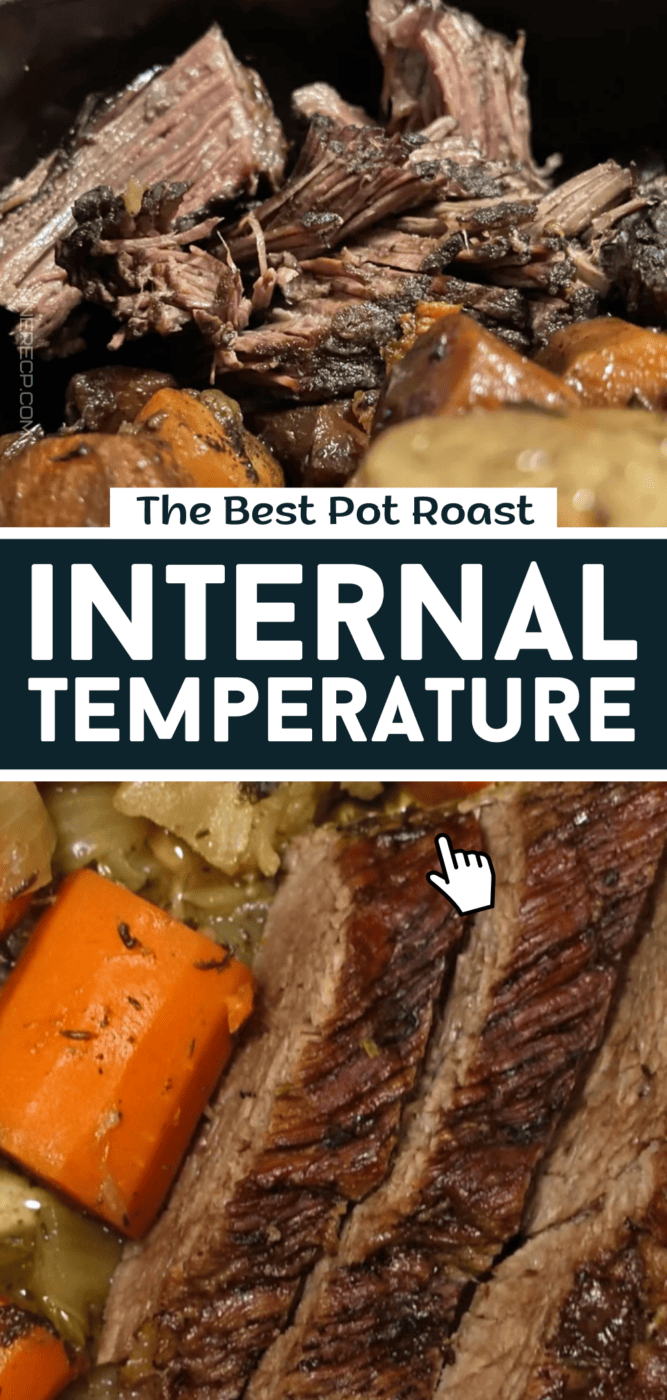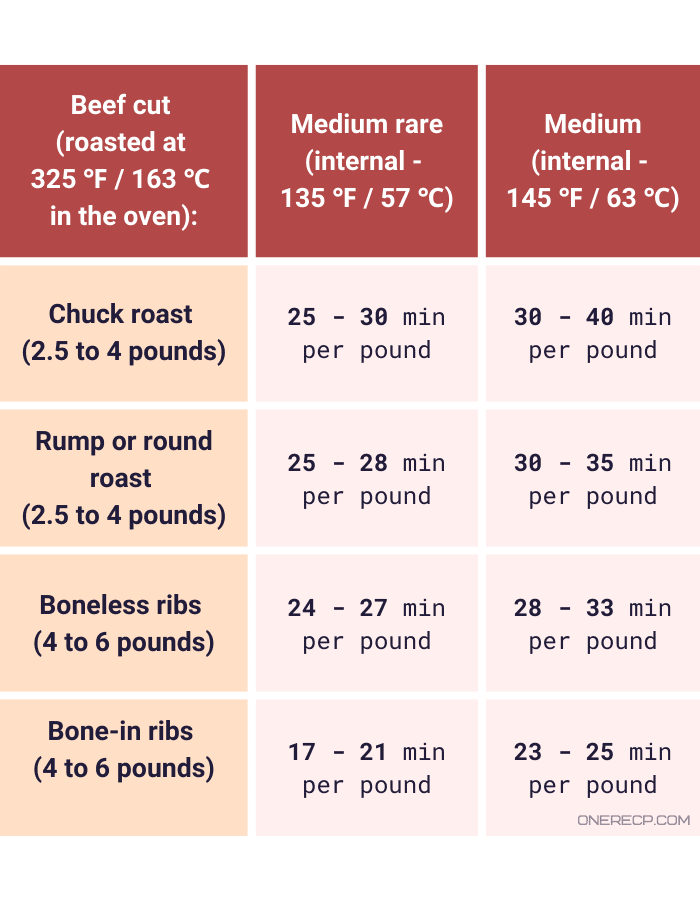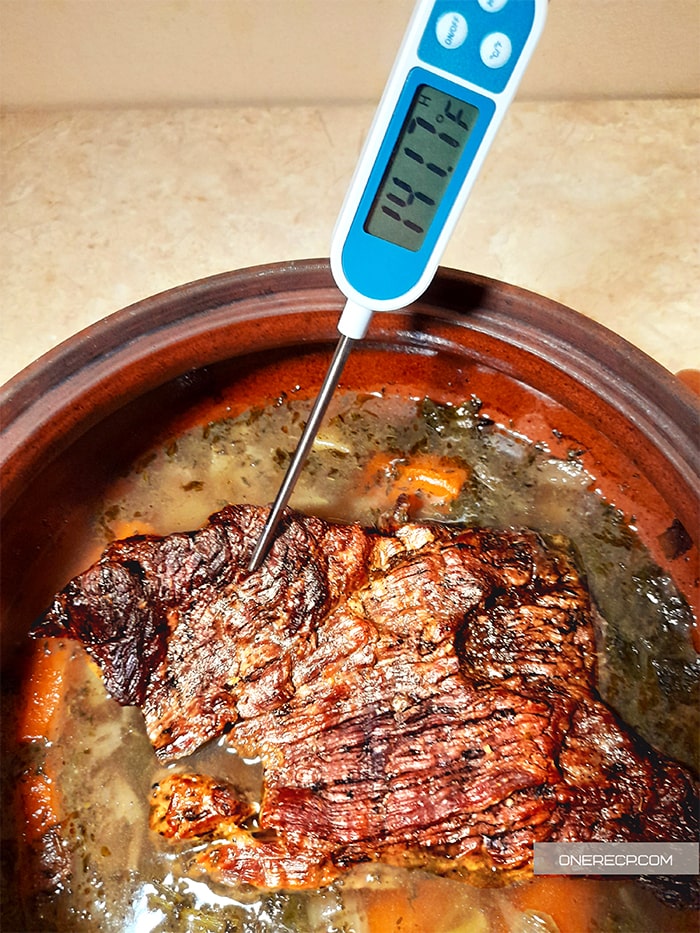Serving a dish of warm pot roast on a chilly winter evening is one of the most comforting gestures you can make.
And the best way to make sure your pot roast always turns out perfect is to measure its internal temperature.
Even though it’s a simple dish, you can easily undercook or overcook it if you try to gauge its doneness without a thermometer.
In this post, I’ll share what’s the best internal temperature for pot roast as well as a chart with estimated cooking times.

What’s the recommended internal temperature for pot roast?
Preparing a juicy pot roast is all about timing and temperature.
If you take it out of the oven too soon you’ll have a chewy slab of meat that’s barely edible.
But if you pull it out a few moments too late it’ll be an overcooked mess.
Since pot roast is typically prepared with chuck or other relatively inexpensive cuts such as the rump roast it needs to be cooked low and slow.
So in order to make a fall apart pot roast you’ll need to cook the meat slowly until it reaches the right internal temperature:
According to the USDA, beef should be cooked to an internal temperature of 145°F at a minimal cooking temperature of 325°F. Roasting beef at lower temperatures increases the risk of a bacterial infection. Always use a thermometer to measure the inside temperature of pot roast before serving.
If you prefer to cook your pot roast to medium rare then the temperature you’re looking for is 135°F.
However, keep in mind that if you opt to cook your pot roast this way, you’re doing so at your own peril.
I like to be on the safe side so I never cook mine below 145°F.
Another thing that’s worth mentioning is that your pot roast will continue cooking once it’s out of the oven or smoker. That’s especially true if you let it sit in your Crockpot on the “Keep Warm” setting because you’re coming home late or something.
As a result, the meat’s temperature will rise with up to 15°F when you let it rest.
The increase in temperature caused by carryover cooking, will be determined by a couple of factors such as the mass, shape, and heat capacity of the meat.
In layman’s terms, this means large roasts will experience a bigger increase in temperature since they can store more thermal energy.
Suggested Article: How Long Can Eggs Be Unrefrigerated?
While it’s certainly true that most bacteria can be neutralized at lower temperatures, you’ll need to keep your roast at 140°F for at least twelve minutes to make it safe for consumption.
And when you roast beef to temperatures lower than 145°F it can’t stay hot for long enough to kill any bacteria that might be present.
Technically, this temperature can kill bacteria if the meat stays hot for long enough but the time needed for this is so long that it becomes impractical for someone who just wants pot roast for dinner.
Following the above advice as a general rule of thumb will help you stay on the safe side with your meal while still being practical.
Pot roast internal temperature and cook times chart
Since pot roast can be made with different types of beef, its cooking time largely depends on the cut of meat you’re using.
Some recipes call for leaner cuts such as the rump round, while others are made with ones containing more fat such as the chuck roast.
Anyways, this roast beef temperature chart should help you out:

Bear in mind that these are only guidelines. In some cases, it may take you a different amount of time to cook two pieces of beef that come from the same sub-primal cut.
This is most often caused by a difference in the shape and size of the cuts.
Thin pieces of meat take less time to cook because heat reaches their center faster.
So if you use two cuts that weigh the same but have different thicknesses, the thicker one will cook slower.
Cooking temperature is another factor that you should take into account when you’re preparing a pot roast.
If you cook your pot roast at a higher temperature than the recommended by the USDA, it will not only take you less time but also increase the effect of carryover cooking. Conversely, roasting at lower temperatures will increase cooking time and decrease carryover.
A cut of beef that’s roasted at 200°F will take almost twice the time than one that’s cooked at 325°F.
How to accurately test the temperature of a beef roast
Even though cook times can be useful, the best way to tell when a pot roast is done is by measuring its internal temperature with a thermometer.
This may seem simple enough, but there are a few things you’ll want to avoid.
Here’s how to accurately measure the temperature of a beef roast:
- Cut a slit so the thermometer can easily pierce the surface of the meat.
- Insert the thermometer into the thickest part of the beef. Try to avoid hitting any bones or inserting the probe in a fatty area.
- Let the probe sit for 20 – 30 seconds.
- Check the temperature.

In case you don’t have a meat thermometer at hand you can simply pierce the meat with a fork and try to tear a chunk.
If the meat falls apart without any resistance, then your pot roast is done.
Otherwise, you should let it cook for a while longer.
Related: How to tell whether your turkey is done without a thermometer?
In any case, using a meat thermometer is a more reliable way to tell whether your pot roast is done cooking and you can also use it for other types of meat.
The Bottom Line
Cooking a pot roast is really simple when you know how to tell when it’s done.
And the best way to do it is to measure its internal temperature with a meat thermometer.
“And when you roast beef to temperatures lower than 145°F it can’t stay hot for long enough to kill any bacteria that might be present.”?
This just isn’t true. Otherwise sous vide meat would be dangerous. It’s not, since time + temp = safety. For example.. A beef bottom round roast cooked at 139 for 24 hours is pasteurized and perfectly safe.
What you’re saying might be true but I think you’re missing on the context here… I don’t think anyone wants to cook a pot roast for 24 hours… Context is important and makes discussing every single exception to the rule redundant… I will, however, reword it in case it’s too confusing.